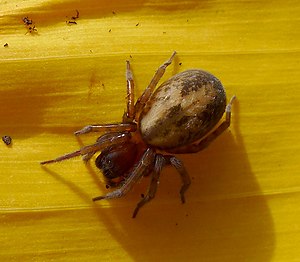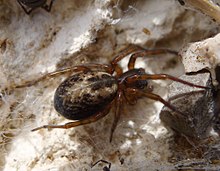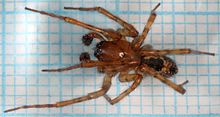Window spider
| Window spider | ||||||||||||
|---|---|---|---|---|---|---|---|---|---|---|---|---|

Window spider ( Amaurobius fenestralis ), female |
||||||||||||
| Systematics | ||||||||||||
|
||||||||||||
| Scientific name | ||||||||||||
| Amaurobius fenestralis | ||||||||||||
| ( Stroem , 1768) |
The window spider ( Amaurobius fenestralis ) is a web spider within the family of the dark spiders (Amaurobiidae). Together with the related cellar spider ( A. ferox ), it is one of the most common species in the family in Europe.
features
The window spider reaches a body length of four to seven millimeters for the males and seven to nine and a half millimeters for the females. The prosoma is yellowish-brown to red-brown, darker on the sides and around the eyes. The abdomen ( opisthosoma ) has a yellowish-gray basic color that merges into reddish at the rear end. In the front third there is a black spot in the middle from front to back, which can become too broader towards the back and is then almost straight and at right angles to the rest of the drawing. The spot is accompanied by two bright side bands. A much narrower row of angular spots joins median, which appear too dark brown towards the back. The legs are red-brown and lightly ringed.

The windows spider similar to the closely related cellar spider ( Amaurobius ferox ) and also closely related -like window spider ( Amaurobius similis ), but is slightly smaller than both.
Occurrence
The window spider is widespread in almost all of Europe with the exception of some southern European countries such as Spain, Portugal and Greece. In the east the distribution area extends to the west of Central Asia and the Caucasus . The window spider is one of the most common types of dark spiders in Europe and is not endangered in its range.
The window spider prefers forests and lives mainly under the bark of dead trees, on the ground under mosses and stones or in cracks in the rock. Observations that it occurs in buildings and that its webs also weave on basement windows could be due to confusion with the similar window spider ( Amaurobius similis ), from which it has not been distinguished for a long time.
Way of life
Like all dark spiders, the window spider also creates a fairly wide-meshed funnel web in its habitat . The cribellate catch threads , which shimmer blue when fresh, are striking . Mating takes place in spring. As soon as this has taken place, the female closes its living tube and expands it into a three centimeter long, oval brood sac. The white egg cocoon is guarded from June to July, in the last of the two months the young spiders hatch and gather around the mother who is still lingering on the remains of the cocoon. This eventually dies after about a week (presumably through a self-dissolution of its own body with the help of its digestive juices) and is accepted by the young animals as the first food. It will probably take two years to develop into an adult animal. This fact stems from the fact that one can see half-grown specimens even in winter.
Systematics
The window spider is the type of the genus Amaurobius . Like most of the spiders described in the 18th century, Amaurobius fenestralis was first incorporated into the genus Aranea and accordingly initially contained the name Aranea fenestralis .
gallery
Epigyne of a female
Cribellum of a female
Individual evidence
- ↑ a b Amaurobius fenestralis in the Spinnen-Forum-Wiki, accessed on March 17, 2019
- ↑ Amaurobius fenestralis from Araneae - Spiders of Europe, accessed on March 13, 2019
- ↑ a b c Heiko Bellmann: The cosmos spider guide. Over 400 species in Europe. Kosmos Naturführer, Kosmos (Franckh-Kosmos), 2nd edition, 2016, p. 182, ISBN 978-3-440-14895-2 .
- ^ MJ Roberts: Collins Field Guide. Spiders of Britain & Northern Europe. Harper Collins Publishers Ltd., 1995. ISBN 0-00-219981-5
- ↑ Hans Strøm : Description over norske insect, andet stekke. Det Trondheimske Selskabs Skrifter 4, pp. 313-371 (Araneae, pp. 362-363), 1768 (first description).
literature
- Heiko Bellmann : The cosmos spider guide. Over 400 species in Europe. Kosmos Naturführer, Kosmos (Franckh-Kosmos), 2nd edition, 2016, p. 182, ISBN 978-3-440-14895-2 .







